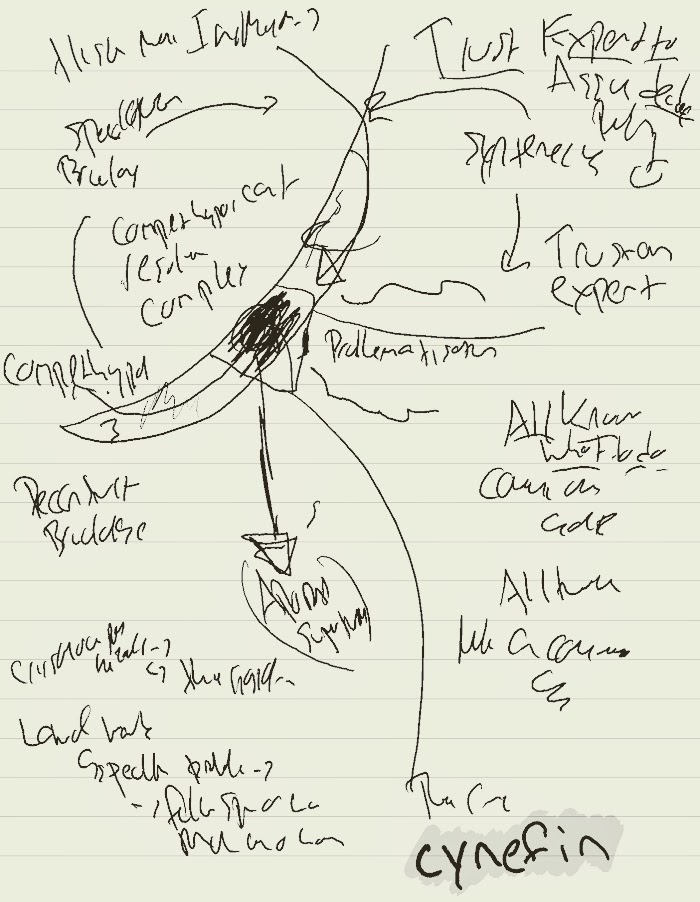
With planning and decision-making, things get confusing. You often feel that you know the variables, then – BOOM – something causes confusion and uncertainty of what to do or how to resolve the challenge. The journey with work complexity is coherence and holding multiple coherent concepts together to make sense of where you are and what progress looks like.
All through covid19, I’ve been fascinated by aporia or aporetics.
When suddenly faced with a challenge or decision and you are utterly unsure what to do or how to resolve the tension – that is aporia.
Apory is any cognitive situation in which the threat of inconsistency confronts us. An apory can be understood as a group of individually plausible but collectively incompatible theses.
Aporia is a current (more amplified?) period of change, emergence, confusion, WTF, and opportunity to show that our work and living communities are vulnerable to unknown and unknowable challenges and hopes.
Examples of aporia:
- Covid19 forced my 1st-grade twins to be in hybrid school for almost one year. Being a father, teacher, and business owner created incongruently consistent roles.
- Within an organization having an objective or goal of 15% profitability – and measuring the goal through proxies of efficiency (time and budget) and customer experience (how the customer experiences the end-to-end process). Efficiency and quality to the customer can be seen as incompatible, AND they are coherent in what they will achieve.
- As you are returning to work, you notice that overall productivity increased from working at home, and you see that customer complaints and returns have increased.
Perhaps a way to think about apory is that it is more than a paradox. It is the feeling you get when you are dumbfounded and feel like you are sinking or unsure how to make sense or a reaction to take. When most of your knowledge, experience, wisdom feels like a swirling tornado of the unknown.
Apory is not necessarily bad or good – it is, by its definition, a way of putting language into a state of confusion.
So, what does this have to do with work, teams, and leadership?
Many parts and decisions within your work are aporetic and benefit from the collectively incompatible theses used to develop a coherent concept to consider, test, or iterate.
I found this helpful when thinking about ‘truth’ or competing views of truth when in aporia.
Coherence is the WD40 of aporetic knots
Dave Snowden and the Cynefin are where I first heard and was curious about coherent-heterogeneity. When you are in a place of aporia (deep confusion or felt knots of uncertainty), there will be many variables vying for your attention or happening.
It is crucial that before you try to ‘tame or control’ things:
- you look at what is available,
- you seek and ask others what they are noticing,
- seek patterns or movement that shows a pattern.
“To agree that someone else’s idea is coherent is a lot easier than agreeing they are right or wrong – the energy cost is lower. So while the parallel safe to fail experiments are very different, we know that they all partake of a degree of coherence sufficient to allow us to move forward using diverse approaches.” Dave Snowden
In confusion (aporia), Coherence implies truth
The information below is taken heavily from Aporetics by Nicholas Rescher:
“To the criticism why should mere coherence imply truth, one should offer the reply that what is at issue here is not mere coherence but coherence with the data.”
What are aporetics?
- The root idea of aporetics lies in the combination of reductive quality control in situations where we have succumbed to the cognitive overcommitment of inconsistency and find ourselves having to salvage some part of what must be abandoned. (italics are my emphasis)
- To assert the consistency of nature as we grasp it is to express one’s faith that the mind will ultimately impress theoretical consistency upon experienced complexity.
The Coherentist approach to inquiry
- Datum set of ‘suitably’ given propositions
- does not need to be true or even consistent
- make presumptive or potential truths – plausible truth candidates
- resolving order to dissonant data by separating the sheep from the goats,
- distinguishing what merits acceptance as true from what does not.
A general strategy of the coherence theory
- to gather all relevant data
- to inventory the available conflict-resolving options that represent the alternative possibilities for achieving overall consistency
- to choose among the alternatives by using the guidance of plausibility considerations, subject to the principle of minimizing implausibility.
I’ve shared some examples, complexity patterns, and back-to-work examples; to better understand your work and self, seek different patterns; and another example of Diversity and Coherence.
When you feel overtly lost and as if you are floating without a tether, time is your ally, even if you only have a little time to choose. Seek some data and points of reference, look for patterns that appear consistent and make sense, align (slightly) with those patterns, and respond until you can see a clear progress step.
Reference:
Aporetics (Rescher, 2009).

